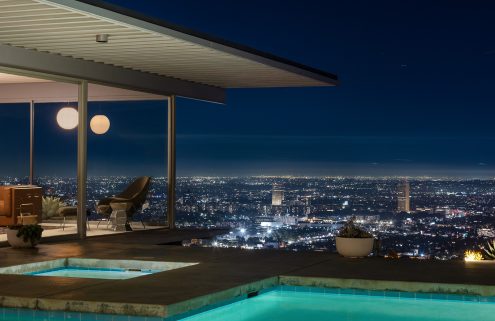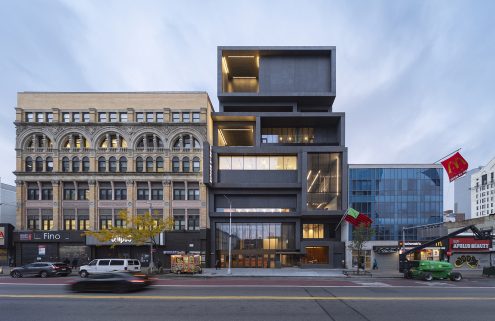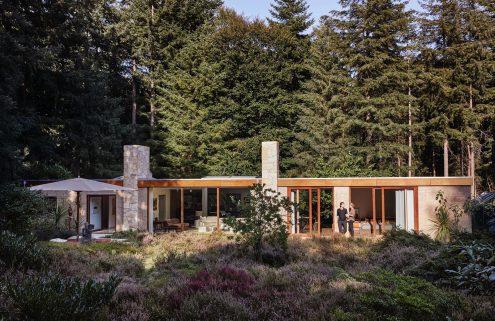It’s hard to remember a time before the pandemic when vaccine passports weren’t a thing. But in 2019, graphic designer and author Stefi Orazi embarked upon an epic research trip across Europe for her new book Modernist Escapes, featuring more than 130 museums and hotels open to the public or available for overnight stays.
Modernist Escapes (published by Prestel) is an essential travel guide for architecture buffs interested in experiencing the modernist life for themselves – if only on vacation.
‘Having written a book on European modernist housing a few years previously, where I interviewed residents across the continent, I was keen not to embark on another year of cheap Ryanair flights at the crack of dawn,’ she says.
Instead of flying, she bought a month-long, unlimited-travel Interrail ticket. She made her way from London to mainland Europe, travelling through the Netherlands, Belgium, Germany, Czech Republic, Austria and elsewhere.
Here, Orazi shares some highlights from her trip.
Jozef Schellekens House in Turnhout, Belgium

I first came across this 1930s modernist house in Turnhout, about an hour and a half from Brussels, on Tripadvisor of all places. With a little investigation, I managed to contact Luc Vanhout, an architect and the grandson of Jozef Schellekens. Not only did he say I could visit the house, but I’d also be welcome to stay in it overnight – as it’s not something available to the public, I was extremely fortunate and excited.

In 1934 Schellekens designed an ultra-modern double house for his own family and a friend, the writer Theo Op de Beeck. Constructed in brick, with its clean lines, large areas of glazing and flat roof, it was significantly ahead of its time – especially for such a conservative town. In recent years, Vanhout has painstakingly restored its original interior, including the brightly coloured walls and bespoke built-in furniture. The house is open to the public on occasion as part of architecture tours organised by AR-TUR.
In 1964 Schellekens’s son Paul and son-in-law Carli Vanhout (Luc’s father) founded the architecture practice Atelier Vanhout & Schellekens, and their modernist buildings can be seen throughout Turnhout.
Sonneveld House in Rotterdam, Netherlands

Sonneveld House, situated in the centre of Rotterdam, is one of the best house museums I’ve visited. The building and its interiors were fully restored in 2002, and it is one of the finest examples of the Dutch functionalist style, known as Nieuwe Bouwen. It was designed in 1933 by Brinkman and Van der Vlugt and commissioned by Albertus Sonneveld, director of the Van Nelle tobacco factory, and his family. Sonneveld, inspired by his business trips to America and stays in luxury hotels, wanted a truly modern home.

The house features all mod-cons, including speakers in every room, kitchen gadgets and even an extravagant shower with 10 showerheads. In contrast to its white rendered facade, colour plays an integral part in the interior – walls are painted in vermilion, cornflower blue and canary yellow, juxtaposed with light and dark greys and browns.
Bauhaus Dorms in Dessau, Germany

I packed for my trip extremely lightly: essentially a backpack with two pairs of trousers, seven T-shirts and a jumper. I did allow myself one book, though. I appropriately took Fiona McCarthy’s excellent book on Walter Gropius, so I had to, of course, stop in Dessau to stay in the original Bauhaus dormitory building.
Considered the birthplace of modernism, it is perhaps the ultimate experience of sleeping in a modernist icon. Gropius founded the Bauhaus school in Weimar, Thuringia, in 1919 and relocated it to Dessau in 1926. The expansive building included a student dormitory called the Prellerhaus. It comprises 28 reasonably priced rooms, each measuring 20 square metres and with a small cantilevered balcony. Guests can have lunch in the authentic canteen or dinner in the restaurant and bar in the basement below the Bauhaus workshops.

The following day I visited the Masters’ Houses – a colony of three pairs of identical semi-detached houses built for the Bauhaus teachers in pine woods a 10-minute walk from the Bauhaus building. I followed that with a guided tour of Törten Estate. In 1926 the city of Dessau commissioned Gropius to design the scheme of affordable housing on the southern edge of the town.
Sainte Marie de La Tourette in Éveux, France

It was Le Corbusier’s monastery, La Tourette, that inspired me to create this book. A friend of mine told me you could stay there. So while finishing my European Estates book, then again for this book, I spent several days in one of the monastic ‘cells’ – equipped only with the essentials for sleeping and studying: a bed, wash-basin, desk and lamp – and dining with the Dominican friars.

Built between 1953 and 1960 in Éveux, 25 kilometres from Lyon, La Tourette was one of Le Corbusier’s last and most important projects. The complex comprises two masses around a central courtyard: a rectangular box containing the church and a U-shaped building comprising the common areas, including study halls, work and recreation halls, and a library on the ground floor. On the lower level are the refectory and cloister (in the form of a cross), leading to the church. The brothers’ cells run around the perimeter of the building on the top two floors.
Covid-19 has scuppered my plans, but I hope to make this an annual pilgrimage.
Ca’ Romanino in Urbino, Italy

Italy was my penultimate stop. It was mid-May by this point, and what I wasn’t expecting were cold weather and torrential rain. It somewhat spoilt the amazing location of Ca’ Romanino, a summer house perched high up on a hill surrounded by vineyards, just outside Urbino in the Marche region. Still, a good excuse to return in finer weather. This wonderful and playful house was designed by one of my favourite architects, Giancarlo De Carlo, in 1967 for his friends Livio Sichirollo and Sonia Morra, professors at the University of Urbino.

The central focus of the main living space is an enormous red cylindrical metal fireplace in a double-height living room, which is echoed by the large, round blue metal door that slides open to the landscape in the study. Ca’ Romanino offers a unique 24-hour stay for up to four guests. One of my favourite features is the enchanting skylight funnels above each bed so that one can look up to the stars at night.
‘Modernist Escapes: an architectural travel guide’ by Stefi Orazi is out now, published by Prestel
7 impeccably dressed hotels for your Greek getaway























